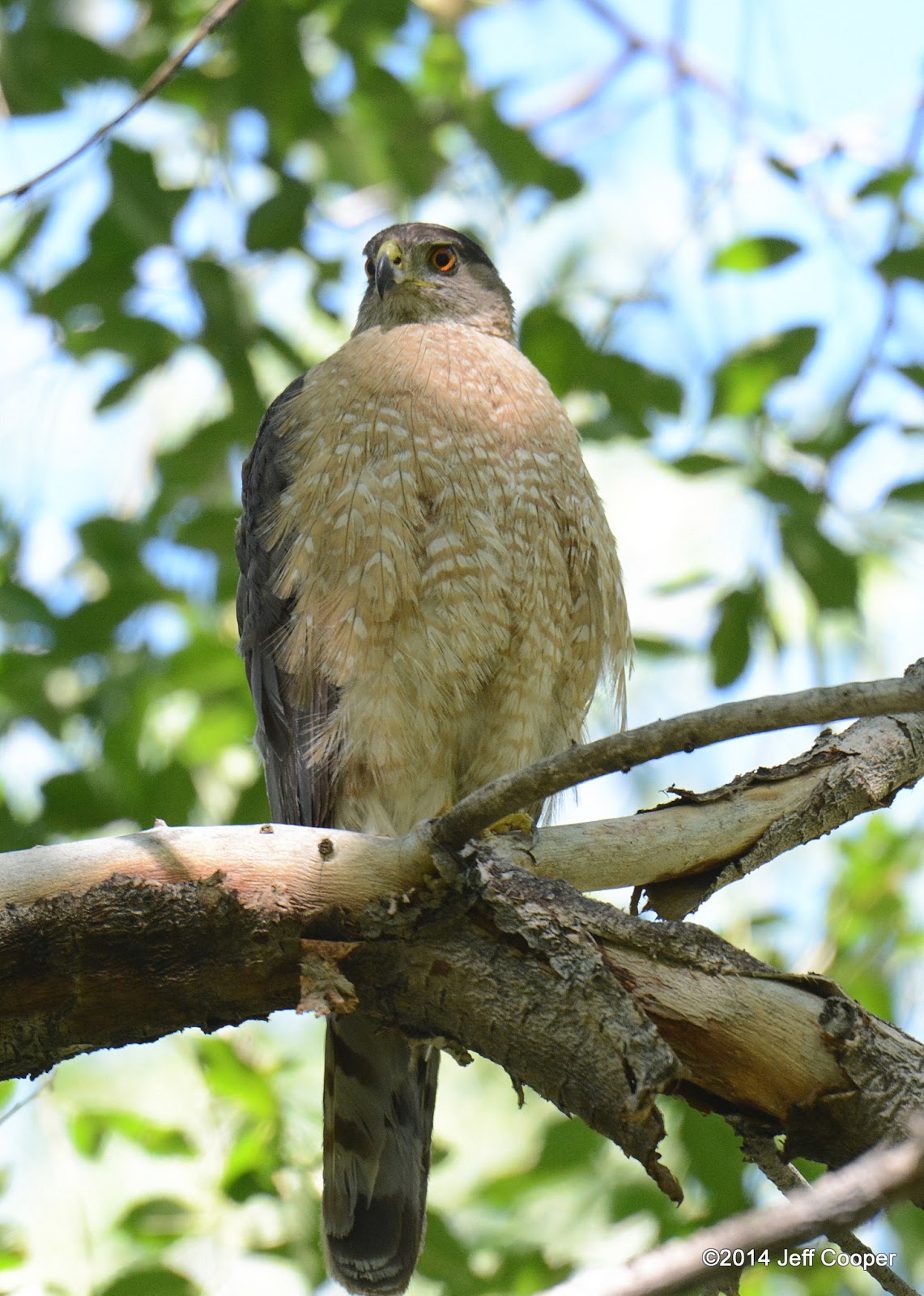I have some good news regarding one of the nest sites that I've followed since that time. I got my first look at chicks when I checked on the nest Thursday after work. I was shocked to suddenly see three fluffy white chicks standing nearly six inches beyond the top of the nest. I later realized there were actually four chicks. I had checked several times recently because I knew the timing for the eggs being laid and when they'd hatch. I knew chicks were growing inside the nest when the mother hawk stopped sitting in the nest and starting standing at the edge of the nest. The image below shows two of the four chicks. You can see that the one on the right probably hatched before the one on the left since it has some juvenile feathers coming in on the chest, shoulders and wings.
The female hawk went from standing at the nest to sitting on the nest on April 23rd. I figured that was probably when she started incubating eggs. I calculated that chicks would start hatching around Memorial Day weekend since the incubation period is 30-36 days for Cooper's Hawk eggs. Chicks are usually in the nest for about 30-35 days after hatching so I estimated that the young birds might start to fledge around the end of June. It seems we are right on schedule.
I didn't visit the nest much during the incubation period, but I did check as I thought hatching may be taking place. I was hoping to see dad bring food to mom and babies, but I never saw that during my brief visits. I guess I didn't show up during feeding times. The next image is typical of what I saw as the chicks were newly hatched inside the nest. Mom would stand at a close guard.
At some point along the way the mother hawk gave up her space in the nest for the growing chicks. I was hopeful I'd see chicks peeking over the edge of the nest during several visits, but the mother continued to be the only visible hawk. I saw dad one day, but he didn't stick around long enough for a photo. Mom, on the other hand provided lots of convenient poses for my lens.
Thursday provided a new and exciting series of events. I stopped by the site after work. I parked my truck and began walking to the stand of trees that housed the nest. I got my first glance of the chicks and could not believe how tall they were standing in the nest. It was as if the nest went from empty to three large chicks overnight. Where were those big chicks hiding all this time?
I looked to my left and mom was in her usual spot, keeping watch over the nest from about 30 yards away. What a beautiful hawk! I couldn't help but wonder,however, "Where on earth was dad? When was he going to appear in his role of provider for these four hungry birds, mom and three hungry chicks?
After admiring mom for a while I turned my attention back to the chicks in the nest. That was until I heard mom start making a few quiet noises. I looked back at her and noticed she was looking to her left. She gave a couple of louder "kak" calls and then flew to where she was looking. That's when I noticed she flew to the male that was waiting in a spruce tree. The two sort of collided with each other a couple feet away from the spruce. Mom flew back toward me and dad moved farther away. I wanted to get an image of dad so I walked his way. I couldn't find him so I turned back toward mom. That's when I realized that dad had actually delivered some prey when the two birds collided near the spruce. Mom was now perched on a branch and plucking downy feathers from what turned out to be a baby bird (Cooper's Hawks primarily eat other birds). She was preparing the prey for delivery to one of her own chicks.
You can see a couple of the plucked downy feathers dropping down to the left of the image below. She would pluck and throw the feathers to one side or other with her beak.
I switched my camera to video mode and captured two short videos while hand-holding the lens fully zoomed to 400mm. It is really hard to hold the lens still and not have the image shake when capturing video. That's what tripods are for, but I didn't have one at the time. The videos actually turned out fairly well.
Here's some short video clips of mom plucking downy feathers from a chick of another bird species before she delivered the flesh to her own chick in the nest.
This short clip is right before mom flies with the prey to the nest.
One chick enjoyed the prey while mom and the other chicks sat contently on my side of the nest. I am fascinated by how mom and dad play their respective roles so well in caring for and raising their young ones. Mom and dad won't eat until after the chicks have eaten and dad will likely deliver a meal to mom before eating his own. Mom is not hunting right now because she is feeding the young and watching over the nest site. Dad will be a busy hawk until the young ones fledge and learn to catch their own prey.













































